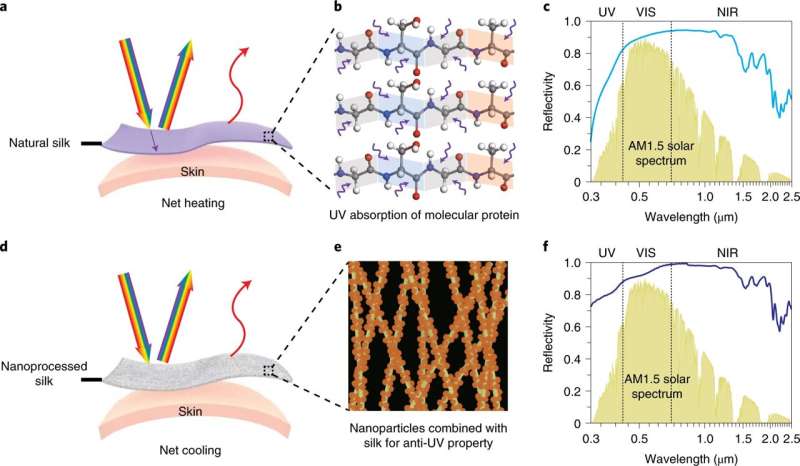Credit: DOI: 10.1038/s41565-021-00987-0
A team of researchers affiliated with a host of entities in China and one in the U.S. has developed a modified textile that can keep skin cooler than materials made of cotton. In their paper published in the journal Nature Nanotechnology, the group describes their approach to developing garments that are cooler when worn in outdoor conditions.
Humans have been wearing clothes for hundreds of thousands of years, and over that time, have been refining them to suit the needs of their environments, which are mostly cold environments. In this new effort, the researchers wondered if it might be possible to create a type of material that would be cooler to wear than other materials and or bare skin under direct sunlight. To find out, they started with silk fabric, a material that has been used for thousands of years because of its looks and comfort.
The researchers noted that silk does a good job of reflecting sunlight in the mid-infrared range, which suggests it could be suitable as a cooling garment material. But because it is made by spiders, it contains a protein component that tends to absorb ultraviolet radiation, making the material and its wearer grow hotter under direct sunlight.
To make the silk material UV reflective, the researchers dipped a standard piece of silk fabric into a liquid solution containing highly refractive inorganic oxide nanoparticles. These adhered to the silk fabric, allowing it to become evenly saturated throughout the material. They allowed the fabric to dry and then tested it to see if the addition of the nanoparticles made the material more UV reflective. They found that under peak sunlight conditions, the temperature under the material was approximately 3.5 degrees Celsius cooler than the ambient air temperature. Next, they placed the material on a patch of simulated skin and found the skin temperature was approximately 8 degrees Celsius cooler than the same type of simulated skin without the material covering. They also found that it kept the artificial skin approximately 12.5 degrees Celsius cooler than standard cotton material. Further testing showed that the material was able to reflect approximately 95% of sunlight, preventing it from passing through to the skin underneath.
More information: Bin Zhu et al, Subambient daytime radiative cooling textile based on nanoprocessed silk, Nature Nanotechnology (2021). DOI: 10.1038/s41565-021-00987-0
Journal information: Nature Nanotechnology
© 2021 Science X Network
























